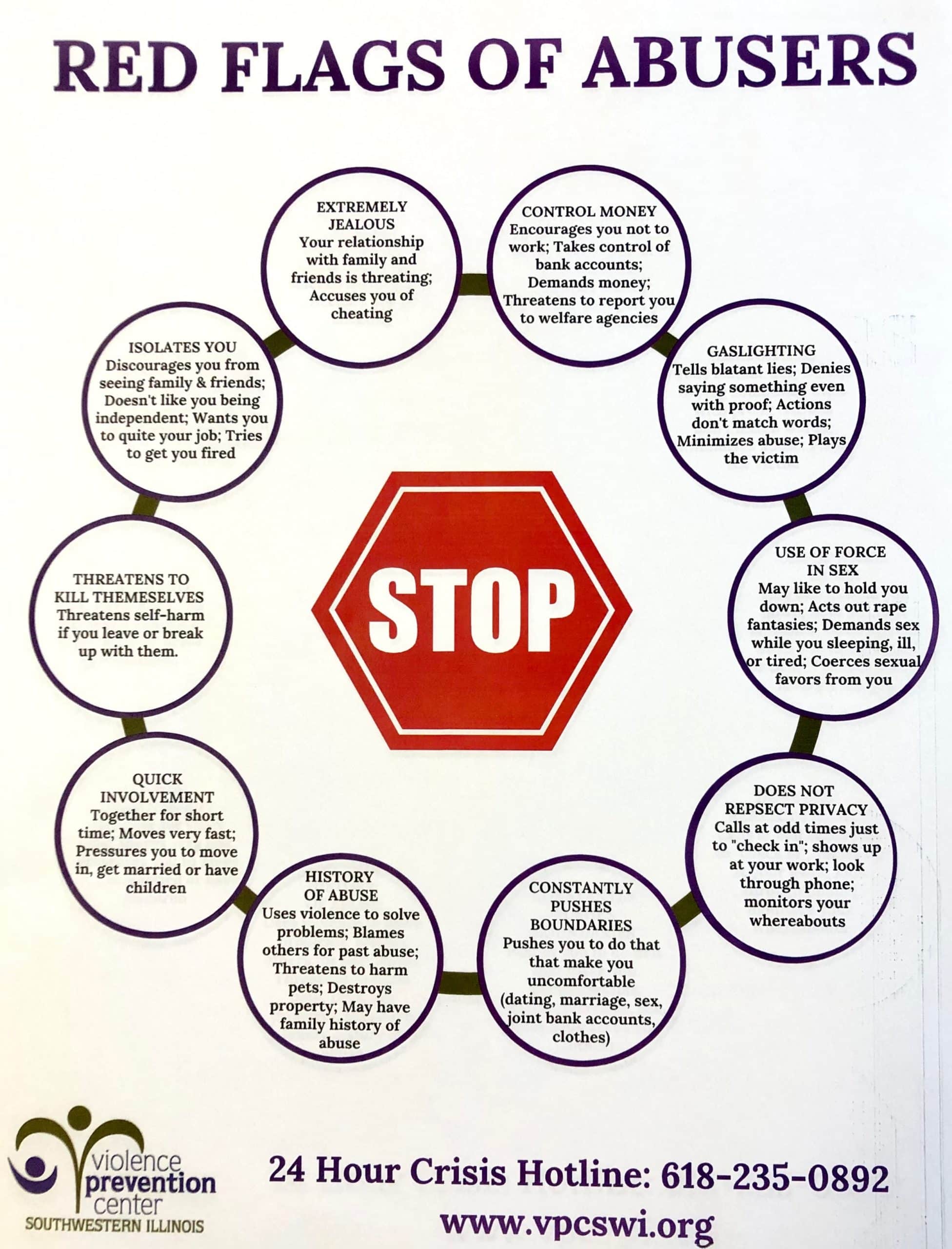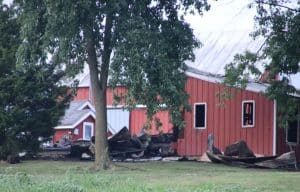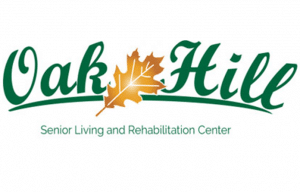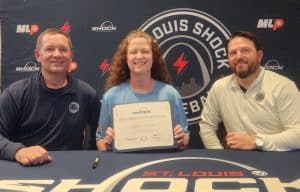Understanding domestic violence
(Editor’s note: This is the first of a three-part series as part of Domestic Violence Awareness Month)
With the COVID pandemic contributing to increasing domestic violence reports globally and high-profile cases of domestic violence hitting national media, there is a lot to reflect on the issue.

Identifying the issue
When one thinks of domestic violence, images of physical struggle are some of the first things that come to mind. As the Violence Prevention Center of Southwestern Illinois often states, domestic violence can present in many different ways – not all of which are physical altercations.
There are two factors domestic violence cases have in common though, VPCSWI Director of Development Melissa Tutterow and local legal advocate Melissa Kaufman said.
“It’s making sure that the abusive person has the control, whether it’s emotionally, financially, physically (et cetera),” Kaufman said, adding that there is one person who possesses the majority of this control. “There are unhealthy relationships … (that can) be mutually unhealthy, but in an actual domestic violence relationship, there is one person who holds power over another person.”
As both explained, domestic violence follows a cyclical pattern. At first, there is a honeymoon stage where everything seems perfect.
“Nobody falls in love with an abuser. They fall in love with a seemingly good human,” Tutterow said.
In cases of repeated violence, the honeymoon stage includes promises that the abuse will stop.
Next there is a tension-building stage, where Kaufman said her clients will often state they feel they are “walking on eggshells.”
Eventually, this leads to an explosion which can include verbal, mental/emotional and physical abuse.
Just as the abuse can vary from relationship to relationship, so can domestic violence warning signs.
Many of these signs are subtle, such as gradually isolating a survivor from their support system by interrupting them every time they make contact with somebody outside the relationship, or blurring the lines between healthy and unhealthy behavior.
“(For example), you have to get permission for things that in previous relationships you wouldn’t have asked permission for. In a healthy relationship we pass information on, we talk about things and we decide mutually, but when one person has the control and the power, that’s the distinction,” Tutterow said.
Abusers may also gaslight, be extremely jealous, push boundaries, move the relationship along at a fast pace and may even threaten suicide if the other person tries to leave.
The impact
Domestic violence also does not discriminate between race, class, gender, sexual orientation or other factors – it can impact anybody. Statistics show, however, some groups are more likely to be impacted by domestic violence than others.
As blackburncenter.org and the National Coalition Against Domestic Violence report, domestic violence is just as likely, if not more likely, to occur in LGBTQ relationships than heterosexual ones.
Statistics distributed by VPCSWI state 44 percent of lesbians, 67 percent of bisexual women, 26 percent of gay men, 37 percent of bisexual men, 30-50 percent of trans people and 43 percent of LGBTQ+ teens experience intimate partner violence. According to the center, transgender women are more likely than their cisgender counterparts to suffer injuries from domestic violence that need medical attention.
Countless studies show racial/ethnic groups may experience higher rates of domestic violence as well. The National Intimate Partner and Sexual Violence Survey found that non-Hispanic Black women, American Indian and Alaskan Native women are more likely to experience physical violence, rape and/or stalking by an intimate partner in their lifetime than White, Hispanic and Asian women.
This number increases for multi-racial, non-Hispanic women.
According to the National Coalition Against Domestic Violence, women are more likely to experience severe intimate partner violence than men, and women between the ages of 18-24 are most commonly abused by an intimate partner.
Tutterow was careful to note that abuse is largely unreported as a whole – especially when it comes to male survivors.
“The national statistics that we use that are certified by the National Domestic Violence Coalition is one in three women and one in seven men will be severely injured by an intimate partner in their lifetime,” Tutterow said. “With that, we’re just talking about severely injured (people). When you talk about more … subtle abuse, it’s probably a lot more widespread. We stigmatize men for getting help. Abuse is underreported, period, in all populations. It’s definitely underreported in male populations.”
What VPCSWI can do
Tutterow and Kaufman stressed that the myriad of resources VPCSWI offers are free and are 100 percent survivor-led.
“All of our services are survivor-led, so they get to decide what happens next, what happens in the future, they get to decide 100 percent,” Tutterow said.
Essentially, action – if any – is determined by the survivor.
“It comes in this office and it stays in this office. If they don’t want it to go anywhere outside of this office, it doesn’t,” Kaufman said of her office at the Monroe County Courthouse. “I don’t call the police if there’s an incident, I let them know that that’s a resource they can call if they feel like they need it, but I don’t make that call for them.”
They must report cases with specific criteria, such as child abuse and elder abuse, however.
Tutterow said there are five main resources VPCSWI provides: a 24-hour hotline, emergency shelter, counseling regardless of one’s point in their journey, legal advocacy and community education/outreach.
The two said the hotline often serves as an introduction to the center. It is always staffed with trained personnel who can speak with concerned citizens for minutes to hours.
“That’s a lot of people’s first point of entry with us,” Tutterow said. “They’re just calling and kind of gathering facts, maybe they’re not 100 percent sure what they’re experiencing is abuse (or) they don’t know where to go or what to do.”
The center provides counseling for both adults and children. One does not need to be seeking emergency shelter to access counseling.
As Tutterow detailed, emergency shelter services include not only counseling and a safe place to sleep, but also a case manager, access to their legal department and more.
“A lot of times when we’re speaking publicly we’ll say, ‘What would you do if you lost half your income today? Because no matter what happens, that’s at minimum what a survivor has done. A lot of times they’ve lost all their income because they don’t have access to their money. And how do you recover from that, and how do you recover from that when you’ve experienced all of this trauma, and you’re probably still experiencing trauma?” Tutterow said.
As the center’s legal advocate for Monroe and Randolph counties, Kaufman helps survivors with “anything court related.” This may include helping file orders, resources, walking them through every step of the process or simply just telling them how to approach the judge, should they choose to do so.
She also works with local law enforcement.
“I get reports from them whenever they go to a domestic (incident) so that I can reach out to the victim to let them know about our services and give them more information and then help them if they do decide to seek counseling services at the time,” Kaufman said, again stressing that it is up to the survivor to decide what avenues, if any, they want to take.
Tutterow added that each VPCSWI county has a multidisciplinary team of the center’s staff, law enforcement, state’s attorneys and other social service agencies that discusses how best to quell domestic violence in their communities and collaborates on cases.
For example, Kaufman said, if there is a residence that police have responded to multiple times, the team will discuss how they can all collaborate to best help the survivor(s).
“I think the biggest take-home message for any survivor is that there is an entire community ready to stand behind you and keep you safe,” Tutterow said.
For those looking to learn more about domestic violence, the center is hosting virtual “lunch and learns” throughout the month.
Additionally, “Silent Witnesses” have been planted throughout the courthouses. Each life-size red cutout honors a person who died of domestic violence with the description attached to it. These short writings tell about the person’s life outside of the domestic violence they endured.
“When someone dies due to domestic violence, the violence becomes their story. That’s all they talk about and how they were killed, who killed them, who is behind (it),” Tutterow said. “This program (the Silent Witness Initiative) sheds light that domestic violence can be lethal, but also gives that victim their story back. So there’s a shield that goes on them that explains who they were as a person, it has nothing to do with their death or anything like that. At this time of year, we just kind of honor them and raise awareness that domestic violence can be lethal.”
To learn more about the Silent Witness Initiative, visit silentwitness.net. To learn more about VPCSWI, visit vpcswi.org or their Facebook page.
Call 618-235-0892 for the center’s 24-hour crisis hotline.






